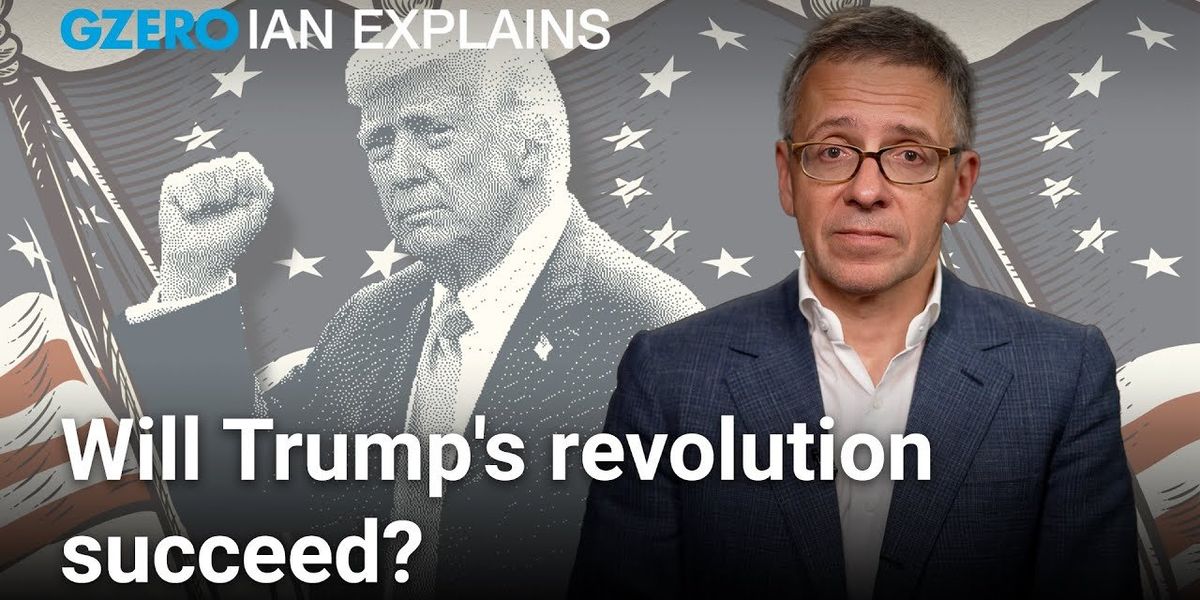Trending Now
We have updated our Privacy Policy and Terms of Use for Eurasia Group and its affiliates, including GZERO Media, to clarify the types of data we collect, how we collect it, how we use data and with whom we share data. By using our website you consent to our Terms and Conditions and Privacy Policy, including the transfer of your personal data to the United States from your country of residence, and our use of cookies described in our Cookie Policy.
{{ subpage.title }}
President Trump has launched a revolution. Will it succeed?
President Donald Trump calls himself a revolutionary—and I actually agree with him. His second term has ushered in sweeping attempts to expand executive power and defang oversight institutions. Congress has rolled over. The DOJ? Under pressure. The only remaining institutional check appears to be the courts—especially the lower ones. So far, federal judges across the country, including some Trump appointees, have pushed back on illegal overreach. As has the Supreme Court on some high profile immigration and trade cases. But what happens when Trump gets tired of losing in court?
GZERO World with Ian Bremmer, the award-winning weekly global affairs series, airs nationwide on US public television stations (check local listings).
New digital episodes of GZERO World are released every Monday on YouTube. Don't miss an episode: subscribe to GZERO's YouTube channel and turn on notifications (🔔).
Next up for the US: Constitutional crisis?
On Tuesday, he issued an executive order that would give him direct control over regulatory agencies that Congress established as independent. The order is designed to “ensure Presidential supervision and control of the entire executive branch,” including the Securities and Exchange Commission, the Federal Trade Commission, the Federal Communications Commission, and the National Labor Relations Board.
The move would change the longstanding balance of powers, giving Trump unprecedented authority, which legal scholars see as part of a long-term strategy by conservative legal activists to weaken the regulatory state.
The order also creates the possibility that Trump could use the agencies’ regulatory powers to reward or punish companies that get on his wrong side, alarming critics who already fear presidential overreach. Trump did not give them comfort on Saturday when he pithily expressed his view of his legal authority with a Napoleon quote: “He who saves his Country does not violate any Law.”
Trump’s many executive orders are being tested in court. The big question looming over that process: If they rule against him, will he yield, or will the United States face a constitutional crisis?
For more on this, read our GZERO Explains piece on it here.
Wooden gavel.
Trump seeks top court’s permission to fire whistleblower protector
The White House relieved Dellinger of his duties on Feb. 7, but a federal judge blocked it three days later and reinstated him. A US circuit court — the second highest in the land — rejected the first appeal, prompting the White House to take the case to the nation’s top court.
The case could provide a window into whether the Supreme Court, with its 6-3 conservative majority, would be willing to limit US President Donald Trump’s executive authority. Republicans have urged the country’s legal system not to stymie the president’s agenda: Vice President JD Vance said earlier this month that “judges aren’t allowed to control the executive’s legitimate power.”
From removing inspector generals and gutting agencies like USAID, to flying undocumented immigrants to Guantánamo Bay, Trump has tried to push the boundaries of his office within the first few weeks of his presidency. His policies have run into a legal wall, though, as groups challenge the moves in court — and sometimes with success.
Whether Trump tries to override the courts is another matter. Last week, he said he will “abide by the courts.” Over the weekend, though, he wrote, “He who saves his Country does not violate any Law,” a quote oft attributed to Napoleon Bonaparte.
With the Trump administration having filed its appeal in the Dellinger case, the Supreme Court must now decide whether it will hear the case. Of the roughly 7,000 appeals that it receives each year, the Court only hears about 100-150 of them.The White House is seen from a nearby building rooftop.
Judge declares White House in defiance of court order on blocked funds
The dispute centers on a White House memo that froze federal funds until they aligned with Trump’s priorities. The Justice Department argues that the administration’s actions are lawful because the money still being blocked was allocated for clean energy projects and transportation infrastructure under Joe Biden’s Inflation Reduction Act, which was stopped under a different executive order signed on Trump’s first day in office. This, they say, is separate from the memo freezing federal funds across the board.
McConnell ordered the government to “immediately restore frozen funding.” But the judge’s statement came a day after Vice President JD Vance posted that judges shouldn't control executive power, as the White House faces a series of blocked court cases – including ending birthright citizenship, restricting access to Treasury Department systems, and nearly 40 other lawsuits against the 53 executive orders he has signed so far.
If the White House does not back down or chooses to ignore the court’s orders, it could call into question whether the judicial branch has the power to constrain the executive, undermining the founding principle of checks and balances, and putting the country on the course toward a constitutional crisis.
